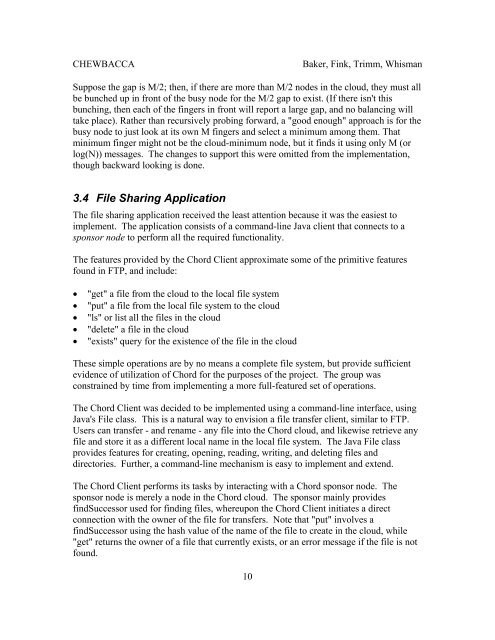Implementing a Distributed Peer to Peer File Sharing System ... - Umbc
Implementing a Distributed Peer to Peer File Sharing System ... - Umbc
Implementing a Distributed Peer to Peer File Sharing System ... - Umbc
You also want an ePaper? Increase the reach of your titles
YUMPU automatically turns print PDFs into web optimized ePapers that Google loves.
CHEWBACCA Baker, Fink, Trimm, Whisman<br />
Suppose the gap is M/2; then, if there are more than M/2 nodes in the cloud, they must all<br />
be bunched up in front of the busy node for the M/2 gap <strong>to</strong> exist. (If there isn't this<br />
bunching, then each of the fingers in front will report a large gap, and no balancing will<br />
take place). Rather than recursively probing forward, a "good enough" approach is for the<br />
busy node <strong>to</strong> just look at its own M fingers and select a minimum among them. That<br />
minimum finger might not be the cloud-minimum node, but it finds it using only M (or<br />
log(N)) messages. The changes <strong>to</strong> support this were omitted from the implementation,<br />
though backward looking is done.<br />
3.4 <strong>File</strong> <strong>Sharing</strong> Application<br />
The file sharing application received the least attention because it was the easiest <strong>to</strong><br />
implement. The application consists of a command-line Java client that connects <strong>to</strong> a<br />
sponsor node <strong>to</strong> perform all the required functionality.<br />
The features provided by the Chord Client approximate some of the primitive features<br />
found in FTP, and include:<br />
• "get" a file from the cloud <strong>to</strong> the local file system<br />
• "put" a file from the local file system <strong>to</strong> the cloud<br />
• "ls" or list all the files in the cloud<br />
• "delete" a file in the cloud<br />
• "exists" query for the existence of the file in the cloud<br />
These simple operations are by no means a complete file system, but provide sufficient<br />
evidence of utilization of Chord for the purposes of the project. The group was<br />
constrained by time from implementing a more full-featured set of operations.<br />
The Chord Client was decided <strong>to</strong> be implemented using a command-line interface, using<br />
Java's <strong>File</strong> class. This is a natural way <strong>to</strong> envision a file transfer client, similar <strong>to</strong> FTP.<br />
Users can transfer - and rename - any file in<strong>to</strong> the Chord cloud, and likewise retrieve any<br />
file and s<strong>to</strong>re it as a different local name in the local file system. The Java <strong>File</strong> class<br />
provides features for creating, opening, reading, writing, and deleting files and<br />
direc<strong>to</strong>ries. Further, a command-line mechanism is easy <strong>to</strong> implement and extend.<br />
The Chord Client performs its tasks by interacting with a Chord sponsor node. The<br />
sponsor node is merely a node in the Chord cloud. The sponsor mainly provides<br />
findSuccessor used for finding files, whereupon the Chord Client initiates a direct<br />
connection with the owner of the file for transfers. Note that "put" involves a<br />
findSuccessor using the hash value of the name of the file <strong>to</strong> create in the cloud, while<br />
"get" returns the owner of a file that currently exists, or an error message if the file is not<br />
found.<br />
10











